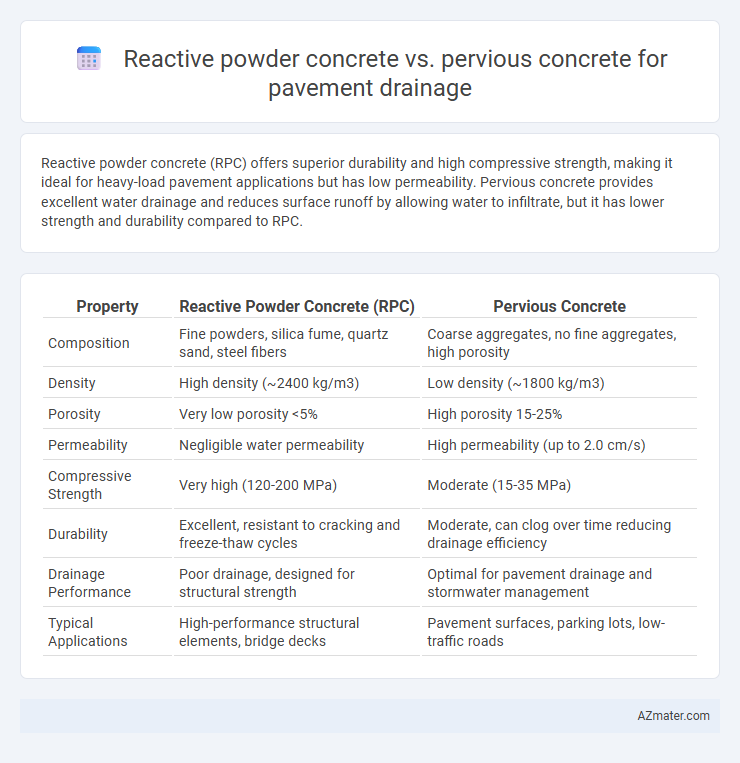Reactive powder concrete (RPC) offers superior durability and high compressive strength, making it ideal for heavy-load pavement applications but has low permeability. Pervious concrete provides excellent water drainage and reduces surface runoff by allowing water to infiltrate, but it has lower strength and durability compared to RPC.
Table of Comparison
| Property | Reactive Powder Concrete (RPC) | Pervious Concrete |
|---|---|---|
| Composition | Fine powders, silica fume, quartz sand, steel fibers | Coarse aggregates, no fine aggregates, high porosity |
| Density | High density (~2400 kg/m3) | Low density (~1800 kg/m3) |
| Porosity | Very low porosity <5% | High porosity 15-25% |
| Permeability | Negligible water permeability | High permeability (up to 2.0 cm/s) |
| Compressive Strength | Very high (120-200 MPa) | Moderate (15-35 MPa) |
| Durability | Excellent, resistant to cracking and freeze-thaw cycles | Moderate, can clog over time reducing drainage efficiency |
| Drainage Performance | Poor drainage, designed for structural strength | Optimal for pavement drainage and stormwater management |
| Typical Applications | High-performance structural elements, bridge decks | Pavement surfaces, parking lots, low-traffic roads |
Introduction to Pavement Drainage Challenges
Pavement drainage challenges primarily involve managing surface water to prevent hydroplaning, structural damage, and reduced pavement lifespan. Reactive powder concrete (RPC) offers extremely high strength and durability but has low permeability, limiting its effectiveness in water drainage applications. Pervious concrete addresses these issues with its high porosity, allowing rapid water infiltration to reduce runoff and improve pavement drainage performance.
Overview of Reactive Powder Concrete
Reactive Powder Concrete (RPC) exhibits ultra-high strength and durability due to its optimized particle packing and low water-to-cement ratio, making it a superior choice for pavement requiring enhanced structural integrity. Its dense microstructure significantly reduces permeability, which contrasts with pervious concrete's porous nature designed specifically for stormwater infiltration and drainage. While RPC offers exceptional resistance to wear and chemical attack, it is less effective for pavement drainage compared to pervious concrete, which prioritizes water permeability and groundwater recharge.
Understanding Pervious Concrete Technology
Pervious concrete technology enhances pavement drainage by allowing water to infiltrate through its highly porous structure, effectively reducing surface runoff and promoting groundwater recharge. Unlike reactive powder concrete, which is dense and designed for high strength and durability, pervious concrete prioritizes permeability with void spaces typically ranging from 15% to 25%. This optimized void network enables efficient stormwater management in urban environments, making pervious concrete a sustainable solution for reducing flood risks and improving water quality.
Comparative Analysis: Material Composition
Reactive powder concrete (RPC) consists of fine powders such as silica fume, quartz powder, and cement, combined with high-strength steel fibers, resulting in a dense, low-porosity matrix with superior durability and compressive strength. Pervious concrete incorporates coarse aggregates and little to no fine materials, creating a highly porous structure designed to facilitate water infiltration and improve pavement drainage. The key difference lies in RPC's impermeability and mechanical performance versus pervious concrete's permeability and drainage capacity, making material composition crucial for selecting the appropriate pavement solution based on drainage requirements.
Hydraulic Performance and Drainage Capabilities
Reactive powder concrete (RPC) offers high compressive strength but limited permeability, making it less effective for pavement drainage compared to pervious concrete. Pervious concrete features interconnected voids that significantly enhance hydraulic performance by facilitating rapid water infiltration and reducing surface runoff. The superior drainage capabilities of pervious concrete minimize hydroplaning risks and improve pavement safety in wet conditions.
Strength and Durability Considerations
Reactive powder concrete (RPC) offers superior strength and durability compared to pervious concrete, making it highly resistant to wear and environmental stressors in pavement applications. While pervious concrete excels in facilitating drainage due to its high porosity, its lower compressive strength and susceptibility to clogging limit its long-term durability under heavy traffic loads. Selecting RPC for pavement drainage ensures enhanced structural integrity and lifespan, albeit with reduced permeability compared to pervious concrete.
Environmental Impacts and Sustainability
Reactive powder concrete (RPC) offers high durability and strength with a dense microstructure that minimizes water permeability, leading to potential runoff and reduced groundwater recharge compared to pervious concrete. Pervious concrete enhances pavement drainage by allowing water to infiltrate through its porous matrix, promoting groundwater recharge and reducing stormwater runoff, thereby mitigating urban flooding and improving water quality. While RPC reduces maintenance frequency due to its longevity, pervious concrete supports sustainable urban water management by balancing structural performance with environmental benefits.
Cost Implications for Construction and Maintenance
Reactive powder concrete (RPC) offers higher material costs due to its advanced composition of fine powders and steel fibers, but its durability reduces long-term maintenance expenses. Pervious concrete, while cheaper initially and promoting effective stormwater drainage, requires frequent cleaning and repairs to prevent clogging, increasing maintenance costs over time. Balancing upfront investment with lifecycle expenses is crucial when selecting concrete types for pavement drainage projects.
Application Suitability in Various Climates
Reactive powder concrete (RPC) offers exceptional durability and high compressive strength, making it suitable for pavements in extreme climates with heavy traffic and freeze-thaw cycles, where impermeability and structural integrity are critical. Pervious concrete excels in permeable pavement applications by allowing water infiltration and reducing surface runoff, ideal for wet climates with frequent rainfall where drainage and groundwater recharge are priorities. Selecting between RPC and pervious concrete depends on balancing structural demands against water management needs according to local climate conditions.
Conclusion: Best Choice for Effective Pavement Drainage
Reactive powder concrete offers superior compressive strength and durability but has low permeability, making it less ideal for pavement drainage applications. Pervious concrete provides excellent water infiltration and effective stormwater management, crucial for reducing runoff and improving pavement drainage performance. For optimal pavement drainage, pervious concrete stands out as the best choice due to its high permeability and contribution to sustainable urban drainage systems.

Infographic: Reactive powder concrete vs Pervious concrete for Pavement drainage
 azmater.com
azmater.com